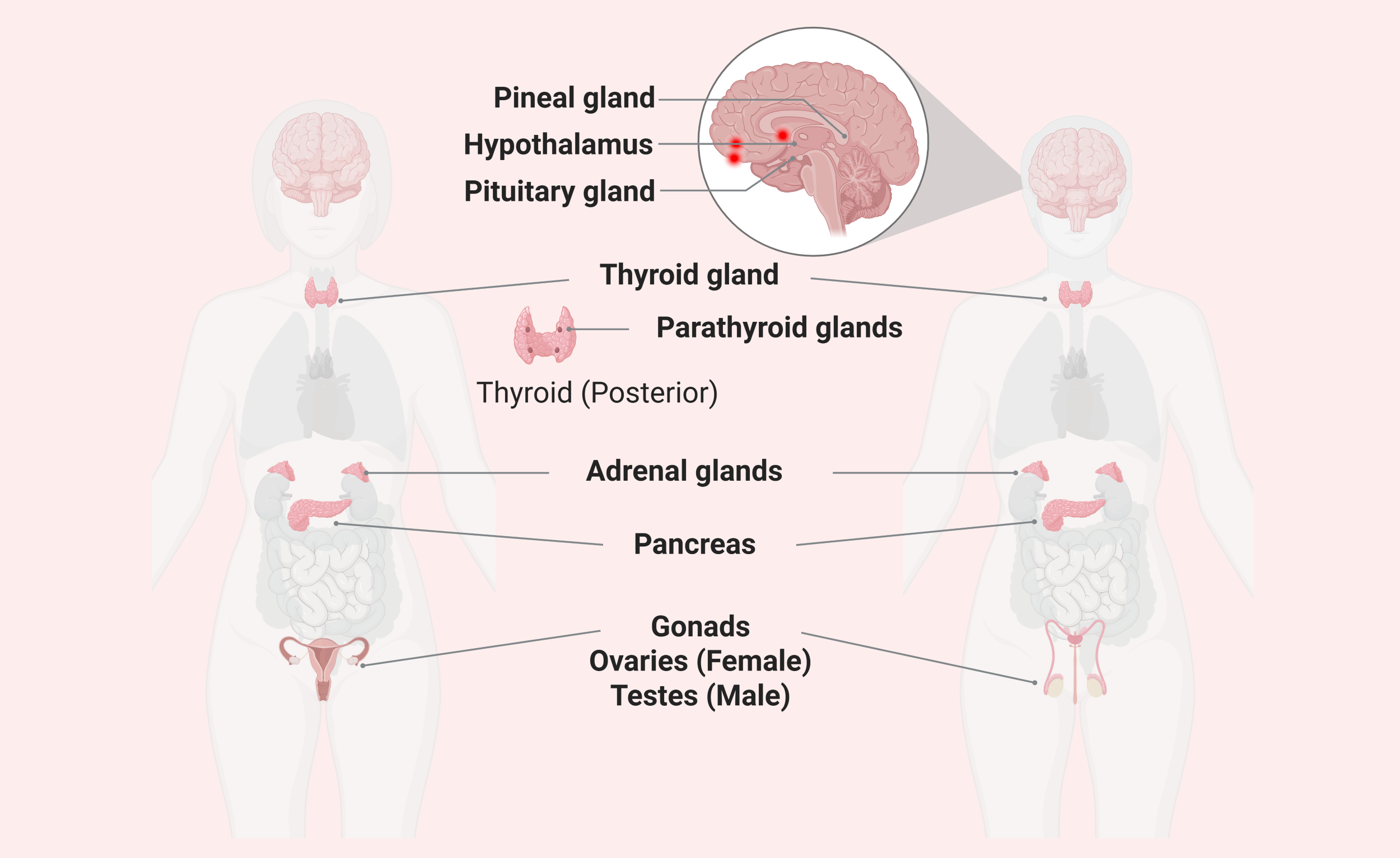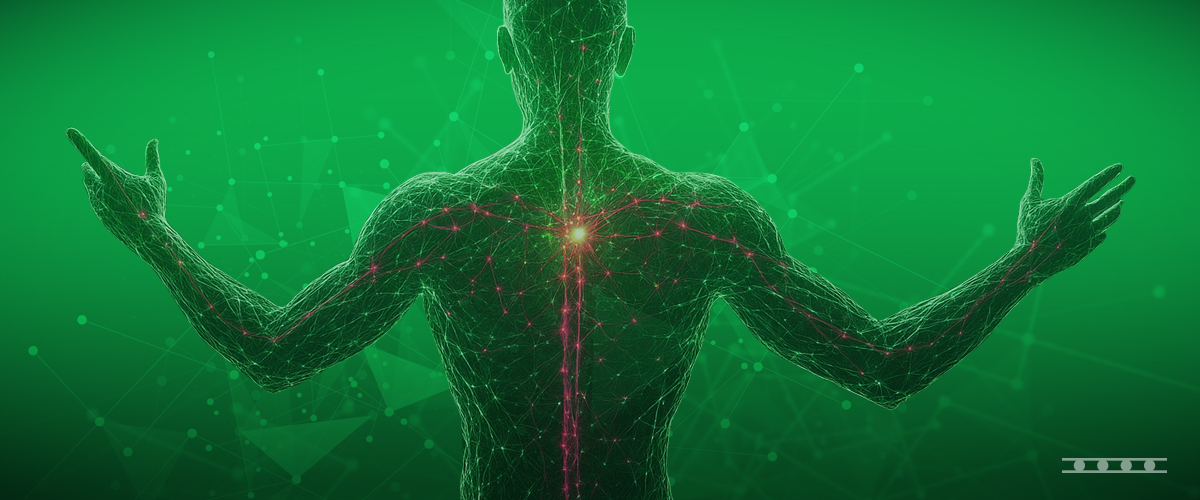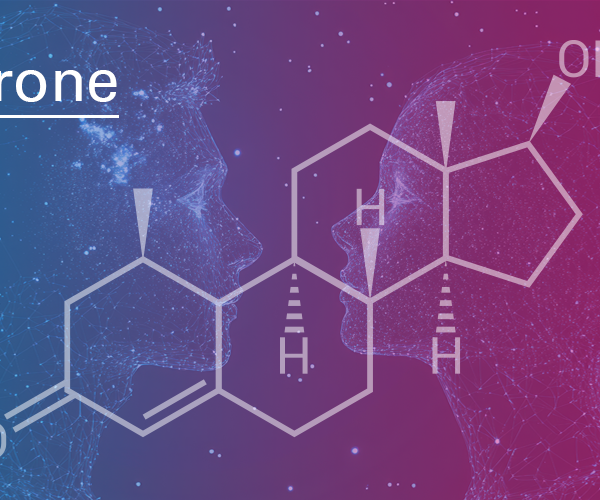Our bodies are a symphony of functions—growing, healing, metabolizing, reproducing, and responding to stresses. Behind the scenes of all these vital processes is a silent but powerful conductor: the endocrine system. Unlike the nervous system which uses electrical signals for rapid communication, the endocrine system quietly creates and releases chemical messengers that travel through the bloodstream to regulate the body’s organs and systems slowly but with a longer-lasting effect.1 Understanding how the endocrine system works, what happens when it malfunctions, and how to diagnose and treat endocrine disorders are essential and foundational to human health.
What is the Endocrine system?
The endocrine system is a network of glands and organs that produce, store, and secrete hormones.1 These hormones act as messengers, telling tissues and organs about what to do and when to do it.2 This network relies on feedback loops, where rising hormone levels inhibit further secretion, ensuring balance and stability in the body’s internal environment (known as homeostasis).1

Figure 1: Location of major endocrine glands in the body. Created in BioRender. Lu, Z. (2025)
Major glands and organs of the endocrine system (Figure 1):
- Hypothalamus: as the body’s central control center, regulates vital functions like temperature, hunger, mood, and sleep by producing hormones and directing the pituitary gland to release or trigger other hormones.3
- Pituitary gland: known as the “master gland”, releases hormones that regulate growth, metabolism, reproduction, and other endocrine glands, under the signaling of hypothalamus.3
- Pineal gland: secrets melatonin to regulate circadian rhythms after receiving information about the daily light-dark cycle from the retinas in your eyes.3
- Thyroid gland: the “Metabolic Thermostat”, plays a vital role in regulating metabolism and energy by producing hormones such as Thyroxine (T4), Triiodothyronine (T3), Reverse T3 (RT3) and Calcitonin (regulates calcium levels).8
- Parathyroid glands: primarily manage blood calcium and phosphorus levels by releasing the parathyroid hormone (PTH).9
- Adrenal glands: regulate stress response, blood pressure, metabolism, and sex hormone production through hormones like cortisol, aldosterone, adrenaline, and androgens.3
- Pancreas: balances blood sugar level through insulin and glucagon.3, 10
- Adipose tissue (body fat): produces hormones called adipokines that regulate appetite, insulin sensitivity, inflammation, blood pressure, and metabolism.4
- Gonads (Ovaries and Testes): produce estrogen and progesterone (ovaries) and testosterone (testes), which regulate physical and reproduction development.1,5
Like a conductor offbeat, endocrine dysfunction sends the body’s hormonal orchestra into disarray
The endocrine system is highly resilient and typically maintains homeostasis without dysfunction under normal physiological conditions. However, when glands produce too much or too little hormone, or when the body becomes resistant to hormone action, endocrine disorders can develop.6 These imbalances may develop gradually and affect various organ systems. Below is an overview of common endocrine disorders categorized by the affected gland:
Pituitary disorders
The pituitary secretes hormones that regulate multiple downstream processes, therefore disruptions can have systemic effects.
- Acromegaly develops in adults from excess growth hormone, typically due to a benign tumor, leading to abnormal enlargement of bones and soft tissues.7 In children, this same hormone excess causes gigantism, characterized by accelerated and excessive growth.
- Hypopituitarism results from the total or partial loss of pituitary function—commonly due to tumors, trauma, or inflammation—leading to reduced secretion of one or more hormones.3 Symptoms vary but may include fatigue, infertility, growth delays, and low blood pressure.
- Cushing’s Disease is often caused by a pituitary tumor producing excess adrenocorticotropic hormone (ACTH), which overstimulates cortisol production, leading to weight gain, muscle weakness, and immune suppression.3
Thyroid disorders
The thyroid regulates metabolism, and its dysfunction significantly affects energy balance.
- Hypothyroidism occurs when thyroid hormone production is insufficient, slowing metabolic processes. Common symptoms include fatigue, weight gain, cold intolerance, and depression.8 In the U.S., Hashimoto’s thyroiditis (an autoimmune condition) is the leading cause, affecting 5 in every 100 people.
- Hyperthyroidism, the opposite condition, involves excessive thyroid hormone, which accelerates metabolism and may lead to weight loss, heat intolerance, irritability, and rapid heartbeat. 8
Parathyroid disorders
The parathyroid glands regulate calcium and phosphorus balance, so dysfunction can lead to serious effects on bones, nerves, and muscle function.
- Hyperparathyroidism is marked by excessive parathyroid hormone (PTH), resulting in high blood calcium levels.9 It can cause bone demineralization, kidney stones, and chronic fatigue.
- Hypoparathyroidism, by contrast, leads to low calcium and elevated phosphorus levels, often causing muscle cramps, tingling, and seizures.9
Adrenal disorders
The adrenal glands produce hormones critical for stress response, metabolism, and blood pressure—imbalances can cause wide-ranging systemic symptoms.
- Addison’s disease involves cortisol deficiency, usually due to autoimmune destruction of the adrenal cortex. Symptoms include fatigue, weight loss, low blood pressure, and skin pigmentation.3
- Cushing’s Syndrome, caused by excessive cortisol (from adrenal tumors or external steroid use), leads to obesity, hypertension, and glucose intolerance.3
- Hyperaldosteronism occurs when adrenal gland releases too much of aldosterone into the blood. It can cause high blood pressure, fatigue, muscle weakness and numbness, and electrolyte imbalances.3
Pancreatic disorders
The pancreas controls blood sugar through insulin and glucagon, and its dysfunction can lead to metabolic disorders like diabetes or rare hormone-secreting tumors.
- Diabetes mellitus is a well-known endocrine disorder where the pancreas either doesn’t produce enough insulin (type 1) or the body can’t effectively utilize that insulin (type 2).10 This leads to elevated glucose levels, fatigue, weight loss, and complications like nerve damage or heart disease.
- Insulinoma and Glucagonoma are rare pancreatic tumors. Insulinomas cause excessive insulin secretion, leading to hypoglycemia with confusion, sweating, and fainting. Glucagonomas produce excess glucagon, causing hyperglycemia, weight loss, and a characteristic skin rash.3
Reproductive endocrine disorders
Hormonal imbalances can impair sexual development, fertility and reproductive health in both sexes.
- Polycystic Ovary Syndrome (PCOS) is a common hormonal disorder in women, often associated with elevated androgens.11 It often presents with irregular menstruation, acne, hirsutism, ovarian cysts, and may lead to infertility.
- Hypogonadism is a condition where the testes produce insufficient testosterone, sperm, or both, leading to impaired sexual development and function.3 Clinical signs include delayed puberty in adolescents and erectile dysfunction, infertility and sometimes gynecomastia (breast development) in adults.
How Are Endocrine Disorders Diagnosed?
Diagnosing endocrine disorders can be difficult due to their vague and overlapping symptoms. To pinpoint the exact disorder, healthcare providers take a comprehensive approach that begins with a thorough medical history and physical examination.6 They often order blood and urine tests to measure hormone levels and other biomarkers, helping assess how well different glands are functioning. Depending on the suspected condition, imaging studies such as ultrasound, CT scans, or MRI may be used to visualize gland size, structure, or tumors.12 In some cases, stimulation or suppression tests are performed to observe how glands respond to specific hormones or medications, offering more insight into hormonal dynamics.6,13 When a hereditary condition is suspected, genetic testing may also be recommended to confirm diagnosis and guide treatment.
How Are Endocrine Disorders Treated?
Treatment strategies vary depending on the specific disorder and the nature of the hormone imbalance. Options may include hormone replacement therapy, such as administering thyroid hormones in hypothyroidism or testosterone in male hypogonadism.6,14 For conditions involving hormone overproduction, medications may be prescribed to suppress gland activity or block hormone receptors.15 In cases where a tumor or abnormal growth is the underlying cause, surgical removal of the affected gland or mass may be necessary, sometimes followed by radiation therapy if the tumor is malignant or not fully resectable.6 Alongside medical interventions, lifestyle modifications—including a balanced diet, regular physical activity, adequate sleep, and stress reduction—can help support hormonal balance and improve overall well-being.6,12
A System Worth Listening To
The endocrine system may operate quietly, but it holds powerful sway over nearly every aspect of human health. Understanding the importance of the endocrine system—and recognizing the signs of dysfunction—empowers individuals to seek early intervention and take control of their health. With advancing diagnostic tools and targeted therapies, most endocrine disorders are manageable, offering hope and quality of life for millions affected worldwide.
References:
1. Hiller-Sturmhöfel, S. & Bartke, A. The endocrine system: an overview. Alcohol Health Res World 22, 153–64 PMID: 15706790. (1998).
2. Cleveland clinic. Endocrine System. https://my.clevelandclinic.org/health/body/21201-endocrine-system (2023).
3. Schifter, M., McLean, M. & Sukumar, S. Disorders of the Endocrine System and of Metabolism. Burket’s Oral Medicine 817–902, doi:10.1002/9781119597797 (2021).
4. Kershaw, E. E. & Flier, J. S. Adipose tissue as an endocrine organ. J Clin Endocrinol Metab 89, 2548–56, doi: 10.1210/jc.2004-0395 (2004).
5. Oktem, O. & Oktay, K. The ovary: anatomy and function throughout human life. Ann N Y Acad Sci 1127, 1–9 doi: 10.1196/annals.1434.009 (2008).
6. Upstatemedicine. Common Endocrine Disorders and Conditions: A Guide to Diagnosis and Treatment. https://www.upstatemedicine.com/2024/01/19/common-endocrine-disorders-and-conditions-a-guide-to-diagnosis-and-treatment/ (2024).
7. Chanson, P. & Salenave, S. Acromegaly. Orphanet J Rare Dis 3, 17 doi: 10.1186/1750-1172-3-17 (2008).
8. Gessl, A., Lemmens-Gruber, R. & Kautzky-Willer, A. Thyroid Disorders. in Sex and Gender Differences in Pharmacology 361–386 doi: 10.1007/978-3-642-30726-3_17 (2013).
9. Markowitz, M. E., Underland, L. & Gensure, R. Parathyroid Disorders. Pediatr Rev 37, 524–535 doi: 10.1542/pir.2015-0076 (2016).
10. Sapra, A. & Bhandari, P. Diabetes. StatPearls Publishing, (2025). https://www.ncbi.nlm.nih.gov/books/NBK551501/
11. Ye, W., Xie, T., Song, Y. & Zhou, L. The role of androgen and its related signals in PCOS. J Cell Mol Med 25, 1825–1837 doi: 10.1111/jcmm.16205 (2021).
12. Connery, L. E. & Coursin, D. B. Assessment and therapy of selected endocrine disorders. Anesthesiol Clin North Am 22, 93–123 doi: 10.1016/S0889-8537(03)00111-1 (2004).
13. Kim, S. Y. Diagnosis and Treatment of Hypopituitarism. Endocrinol Metab (Seoul) 30, 443–55 doi: 10.3803/EnM.2015.30.4.443 (2015).
14. Corona, G., Rastrelli, G., Vignozzi, L. & Maggi, M. Emerging medication for the treatment of male hypogonadism. Expert Opin Emerg Drugs 17, 239–259 doi: 10.1080/14728214.2016.1226799 (2012).
15. Kravets, I. Hyperthyroidism: Diagnosis and Treatment. Am Fam Physician 93, 363–70, PMID: 26926973. (2016).




